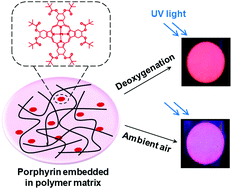Optimization of bright, highly flexible, and humidity insensitive porphyrin-based oxygen-sensing materials†
Abstract
There is a strong demand for reliable oxygen sensors in the fields of fitness tracking, health monitoring, and medical diagnostics. Recently, oxygen-sensing materials based on phosphorescence quenching by oxygen have attracted interest due to their high sensitivity, rapid response, and suitability for directly imaging oxygen distribution on large tissue areas. Here we tested different compositions of metalloporphyrins and their support matrices and identified optimal materials that can be applied to oxygen-sensing devices. Our results showed that a pivaloyl-terminated metalloporphyrin embedded in poly(propyl methacrylate) (PPMA) exhibits the highest porphyrin emission brightness and oxygen-dependent phosphorescence intensity changes can be easily visualized even by eye under ambient light. In vivo studies revealed that our PPMA-based, highly breathable oxygen-sensing films can be used to non-invasively detect changes in tissue oxygenation in a rabbit model, a promising step for integration into wearable devices. In addition, it was found that an alkyne-terminated metalloporphyrin embedded in tetraethyl orthosilicate (TEOS) shows the most rapid response time. The detailed composition exploration and material characterization described in this study provides a good resource towards developing more versatile oxygen-sensing devices.



 Please wait while we load your content...
Please wait while we load your content...